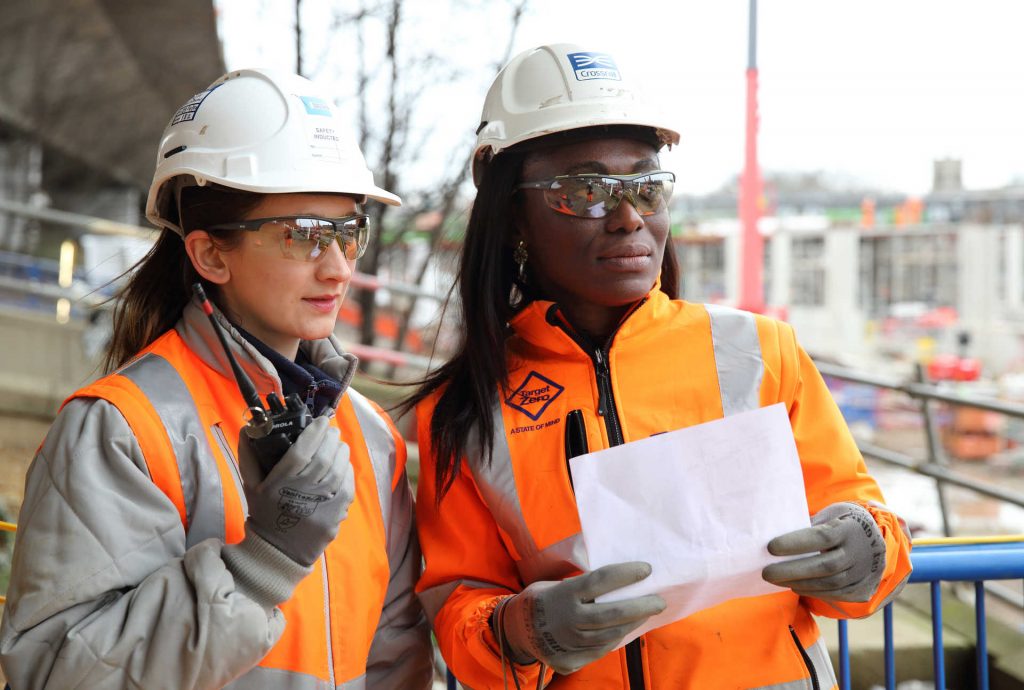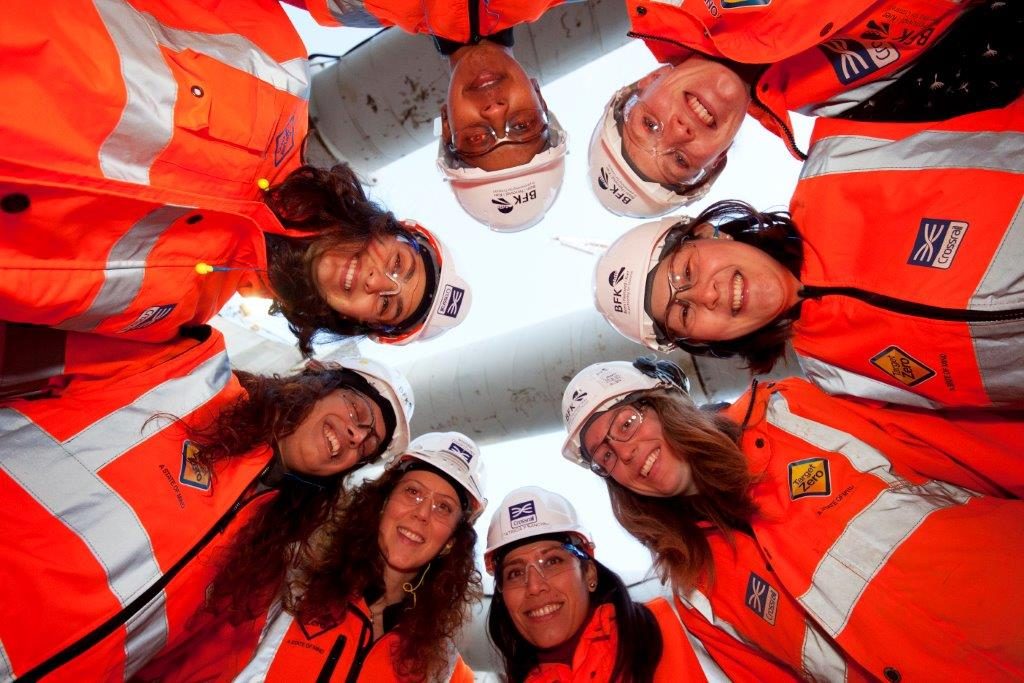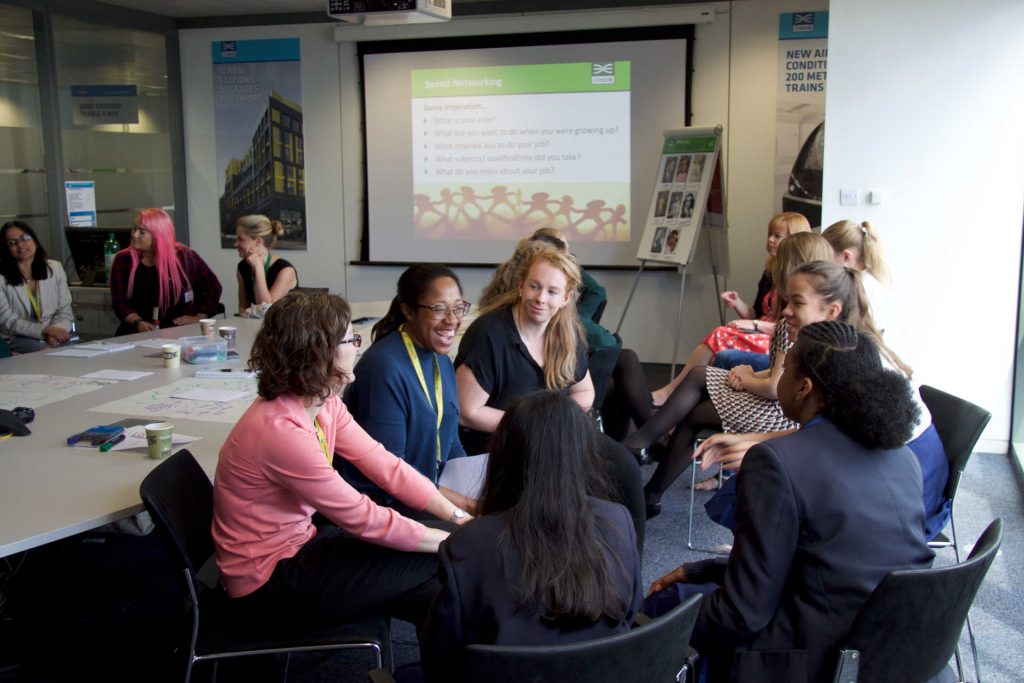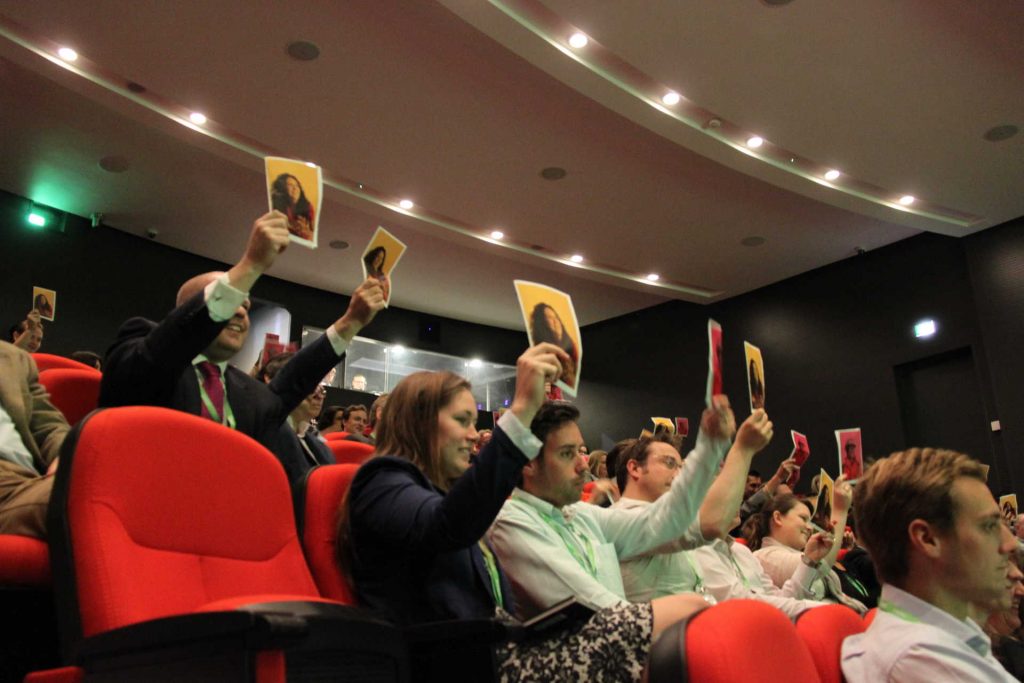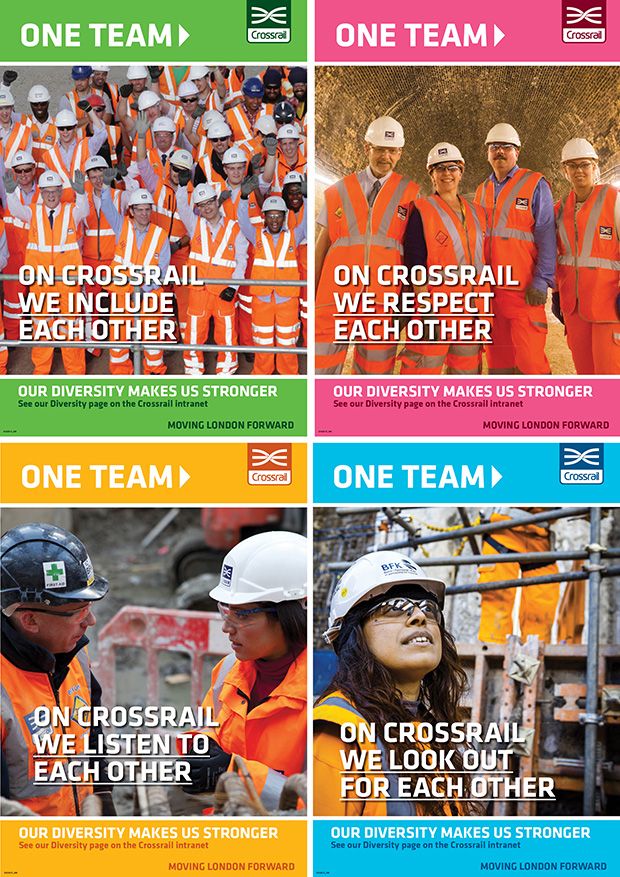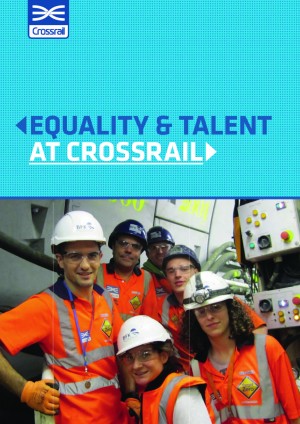
Equality & Diversity Strategy
Document
type: Case Study
Author:
Nathan Pascutto
Publication
Date: 27/09/2016
-
Abstract
Crossrail is a diverse organisation that over its lifetime will bring approximately 55,000 people together from many different backgrounds and employers. This paper discusses Crossrail’s approach to managing equality and diversity across the programme whilst ensuring getting the right people for the right job. It describes the development of the Equality and Talent Strategy and how it was embedded across the project.
Key factors include the approach to diversity and inclusion by focusing on the health and safety of our diverse workforce; devolving the implementation of equality and diversity actions to directors and their team; raising the profile of equality and diversity through communication channels and events; celebrating and promoting the contribution made by a diverse workforce and Implementing an accessible and high-quality learning and development programme to support the equality strategy’s implementation.
This case study would be of interest to: senior managers; HR Directors; HR practitioners; Diversity & Inclusion Specialists; Social Sustainability Specialists, Health &Safety Directors, Health & Safety Specialists, Occupational Health professionals.
-
Read the full document
Introduction and Context
Crossrail is a diverse organisation bringing people together from many different backgrounds and employers. When completed in 2018, there will be 118 kilometres of new railway from Shenfield and Abbey Wood in the east, to Heathrow Airport and Reading in the west, including the construction of 10 new stations. Crossrail required a talented workforce to deliver the railway, with over 10,000 people working on the project at its peak and a total of 55,000 forecast throughout the construction of the project.
Crossrail’s Equality and Talent Strategy sets out Crossrail’s commitment to workforce diversity, both within Crossrail and within the supply chain. Through Equality and Talent, Crossrail aimed to create an organisational culture where everyone working on the project felt valued and included and where individuals were empowered to achieve their full potential and make the biggest possible contribution to the success of the programme.
This case study sets out the equality and diversity considerations for the Crossrail project. It does not, however, consider the equality of access elements of the operational railway, the Elizabeth line, which will open in 2018.This learning is planned to be set out in a future learning legacy paper.
Inclusive Health & Safety of the Diverse Workforce
This legacy paper further provides an introduction to the concept of diversity and inclusion, being integrated into health and safety. The challenge for Crossrail is to ensure the health and safety policies are inclusive of all our workers.
Crossrail continues to expand understanding, embedding knowledge of how the core issues of language, fatigue and general wellbeing impact our diverse workforce. Crossrail’s approach to inclusion within health and safety is due to be published in March 2017.
Diversity in London and the South East
London is widely considered to be one of the most ethnically diverse cities in Europe. The Office for National Statistics’ Census in 2011 revealed that within London, over 300 languages are spoken [1] with white Britons accounting for less than half (45%) of its population, and one in three residents being foreign-born. [2]
Diversity within the Construction and Engineering Sector
Diversity within the construction and engineering sectors within the UK has remained relatively unchanged over the last two decades. In 2005, it was argued by Dainty et al (2005) that construction is the most white male dominated of all major UK sectors; an industry segregated both horizontally and vertically by gender and ethnicity. [3] There has, however, been a shift within the sector with a greater focus on diversity and equality across the workforce. Much of this work is being led by industry organisations such as the Construction Industry Council as well as client delivery organisations such as Crossrail building on the work developed by the Olympic Delivery Authority.
Diversity data across the construction sector has previously been fragmented with no clear picture of the construction workforce, and little reliable benchmarking data. The equality and diversity data which has been available has generally been sector specific and has been produced by sector bodies as they seek to make changes.
The introduction of the Equality Act in 2010 was a positive catalyst for equality and diversity in the construction sector with the publication of several major reports including the Construction Industry Council’s 2009 Diversity Panel report on Diversity in the Construction Sector [4] and the Equality Human Rights Commission 2010 report Equality and Diversity: good practice for the construction sector. [5]
The Construction Industry Council Diversity Panel’s 2009 report published a comprehensive overview of diversity with the construction sector, ahead of the introduction of the Equality Act in October 2010. [6]
Crossrail used the UK Contractors Group’s Diversity Index to assess its diversity and equality performance. The UKCG Diversity Index took into account the diversity of the whole of the UK construction sector. Crossrail also referenced the 2011 Olympic Delivery Authority’s diversity and equality performance, seen as an exemplar of a London-based project at the time:
UKCG Diversity Index ODA Data 2011 Women 17%* 5%* BAME 7% 24% Disability 0.4% 1.2% Under 25 11% Not reported * The ODA data only represents women who were working on site, where the UKCG Diveristy Index also includes some office-based staff
Figure 1 – Diversity Statistics for the Construction Sector – UKCG & ODA
The Legal Framework
The Equality Act 2010, provides a legal framework to protect the rights of individuals and advance equality. Importantly, the Act provides a safety net to prevent discrimination for all individuals across nine protected characteristics.
Under the Equality Act, Crossrail is also subject to the Public Sector Equality Duty. The purpose of the duty is to integrate equality into the day-to-day business of public authorities. Transport for London is a named body under the Duty and as a subsidiary of Transport for London, Crossrail Limited is required to meet the Duty.
The Equality Act 2010 set the minimum standard required for the project. Crossrail’s equality and diversity ambition sits above this minimum requirement and is embodied in Crossrail’s values, policies and procedures.
The Business Case for Diversity
The business case for diversity has steadily grown over the last decade with more organisations recognising the business benefits associated with effective diversity and equality policies and practices.
The Equality and Human Rights Commission’s report: Equality and Diversity: good practice for the construction sector identified several benefits to business with diverse workforces, including:
- Efficiency savings through improved staff retention
- A wider pool of talent available to the industry from under represented groups
- A more diverse supply chain with better support for small business
- Improved on-site working relationships based on respect for everyone’s differences
A CIPD report, Diversity: Stacking Up the Evidence [7], also set out the key benefits for businesses as a result of an effectively diverse organisation, which included:
- Greater access to different perspectives and sources of information
- Greater understanding of clients
- Better communication with clients
- Increased legitimacy
The Work Foundation concluded that there is a strong link between diversity and high performing organisations, particularly in regards to improved performance, improved employer image and improved ability for organisations to respond to change through creativity and innovation. [8]
Figure 2 – The Business Case for Diversity
Crossrail Equality Impact Assessment
In 2006, the Department for Transport, Transport for London and Crossrail Limited jointly published an Equality Impact Assessment [9] to review the Crossrail project, and policy objectives which were likely to benefit or adversely impact on priority groups. UK Government research from 2003 recognised that transport can be a significant factor to social inclusion. [10]
The Equality Impact Assessment considered seven priority groups. The priority groups selected were in line with Transport for London’s equality guidance at the time. Crossrail Limited added the socio economic deprivation group due to the benefits that Crossrail was expected to deliver in regeneration of deprived areas of London and the South East.
Further information on Crossrail’s response to the socio-economic case is included in the London Living Wage and the Addressing Skills Gaps through Direct Intervention case studies.
Priority Group Definition Age Children and young people up to the age of 25 and people over 50 Disability All disabled people, such as those with mobility or sensory impairments, learning difficulties and mental health problems Socio-economic deprivation Those in the 20% nationally most deprived areas Religion or belief Minority faith groups including Buddhist, Hindu, Jewish, Muslim and Sikh Gender Women and transgender people Race Asian, Black Asian, British, Black, Black British, Chinese Mixed, Gypsies, Travellers and other Sexual Orientation Lesbians, gay men and bisexual and transgender people Figure 3 – Priority Groups within the CrossrailEquality Impact Assessment
The Equality Impact Assessment considered the impact of Crossrail’s construction and operation on priority groups, both on a route-wide and local location basis. As part of the assessment process there was a programme of consultations with mitigation actions assigned to address any identified impacts.
The Equality Impact Assessment concluded that the Crossrail project would deliver significant benefit to priority groups identified both during construction and operation, particularly in regards to:
- Changes in employment, including accessibility to additional job and education opportunities and commercial and residential development
- Improved access and journey times to key services, such as access to universities, hospitals and major centres
- Improved access for people with restricted mobility, including independent step-free access for people of restricted mobility.
The Early Years – Prior to 2013
Crossrail introduced its Equality and Talent strategy in 2013. Prior to this time, Crossrail delivered equality and diversity across the project through its equality and diversity policy and procedures which set out Crossrail’s commitment and approach to equality and diversity across the project workforce.
Accountability for delivering equal and diverse outcomes was mainstreamed across all teams within the organisation. At a practical level, this meant that all directors and senior managers, had as part of their objectives, responsibility for equality and diversity requirements within their work areas.
Overall, the approach of mainstreaming worked well, particularly in regards to the following elements:
- diversity and equality monitoring and reporting
- leadership and ownership of Crossrail’s diversity and equality agenda by the Executive and Investment Committee and the Crossrail Board
- embedding diversity and equality in Crossrail procurement through contracts and partnerships
- the development and implementation of performance assurance frameworks to assess contractor compliance
- the design and delivery of annual Respect Weeks to raise diversity awareness and celebrate workforce diversity
- project-wide equality and diversity engagement, including communications and campaigns
During this period, Crossrail established an Equality Working Group, which brought together individuals from across the project, including contractors, to drive equality across the project. The core membership was predominately management from across the project, however, all staff had the opportunity to participate as extraordinary members of the Equality Working Group. The Equality Working Group worked well as a forum bringing members together from across the project to drive forward equality and diversity and to share best practice.
Why a Strategy Was Developed
In 2012 the Crossrail project moved into the peak of its construction workforce to support the civils and tunnelling phase. At this point, it was considered that Crossrail had an opportunity to work constructively with the industry and the supply chain to drive forward equality and diversity improvements. Crossrail considered that the opportunity would be best executed with a standalone equality and diversity strategy which built on Crossrail’s achievements, and which set out a unified vision and strategy for equality across the project that aligned with the Crossrail values: Respect, Integrity, Safety, Collaboration and Inspiration.
Diversity and the Link with Health & Safety
In 2015, Crossrail integrated diversity and inclusion within its Health & Safety strategy. The aim was to introduce a progressive approach towards health and safety, delivering part of Crossrail’s legacy as industry leaders in health and safety.
This approach is being delivered by:
- implementing diversity and inclusion components into the existing health and safety strategy
- research and campaigns directly targeted to specific demographics of visible/non-visible minorities working on site
- external engagement of supporting and engaged organisations.
How the Strategy was Developed
The Equality and Talent Strategy sits along-side Crossrail’s People Strategy, Health & Safety Strategy, Sustainability Strategy, and the Skills and Employment Strategy. These strategies collectively outline how Crossrail addresses the people challenges on the project; improves diversity and equality; delivers a safer and more inclusive project and ideally proving to be a lasting skills and employment legacy. The Equality and Talent strategy was driven by the then newly adopted values of Safety Integrity, Respect, Collaboration and Inspiration.
In a fast-changing organisation that needed to evolve with each stage of the project the typical approach of setting workforce profile targets was considered but not adopted. The overall diversity of the workforce was monitored to understand the level and degree of diversity; but workforce diversity targets were not set. Crossrail instead focused on qualitative measures which supported the values, such as:
- Meeting and maintaining the Investors in People Standard
- Promoting Crossrail’s commitment to diversity through media campaigns
- Blind recruitment — a process of removing personally identifiable information from the recruitment process in order to reduce the impact of unconscious bias
- Collection of diversity data during the application process to monitor Crossrail’s reach and attraction to a diverse talent pool
- Trained recruitment consultants who are aware of equality and diversity obligations and providing equal opportunities
- Making reasonable adjustments for disabled candidates during the recruitment process
- Appointing highly-skilled HR professionals to each recruitment panel to support fairness during the recruitment process
- Advertising all vacancies widely, including supply chain vacancies though Job Centre Plus so that they were accessible to the widest range of candidates, including those who were long-term unemployed
- Reporting on diversity to all levels of the organisation from staff through to the Crossrail Board.
Equality and Talent Objectives and Aims
The Equality and Talent strategy outlined eight key objectives, which aimed to improve and mainstream diversity and equality across the Crossrail project.
Objective Aim Creating opportunities for all Making diversity happen by improving what we do Empowering change Enhance the capacity of individuals and teams to make choices that will transport into equality and outcomes Transparency and openness Share information and ensure there is openness in how we do things and what we achieve Embedding equality Leading by example, embedding equality in everything we do and making it an integral part of our policies and programmes Leadership and governance Make equality a formal part of the governance structure at the highest levels, owned by the leadership with a prominent profile in the Crossrail Sustainability Strategy Supporting local action Give teams the freedom to work separately or together to innovate and find solutions to improve equality Celebrating diversity To inspire and encourage others we need to promote and profile our achievements Legacy Share the knowledge and the lessons learned from the Crossrail diversity strategy with future projects and industry Figure 4 – Equality & Talent Objectives & Aims
Priority Themes
As part of Equality and Talent, Crossrail identified three priority themes that would potentially have a lasting impact. These were identified following feedback from the 2013 Crossrail Diversity Conference. This was an event, supported by external speakers, and led by the CRL Chairman and Chief Executive. The Conference brought together staff from across the project to celebrate diversity and to share ideas about what strategies could be implemented at a local level to improve equality performance. The priority themes suggested by the 2013 Diversity Conference were:
- Raising the profile of construction to women
- Inspiring future talent
- Raising awareness of disability and the workforce
Examples of achievements in each of the priority themes:
1. Raising the Profile of Construction to Women
Crossrail partnered with Women into Construction to increase the opportunities for women to gain work placements and paid employment on Crossrail. Women into Construction worked closely with the Crossrail Jobs Brokerage, which in turn worked with Jobcentre Plus, to provide employment opportunities on the Crossrail project for local unemployed people.
Since January 2015 to August 2016, nearly 200 people were helped, with 27 women gaining a work placement and 25 women gaining employment on Crossrail.
Future projects are recommended to establish partnerships to deliver targeted diversity interventions at the beginning of the projects, so they have the maximum opportunity to have a positive impact over the project lifecycle.
Crossrail actively worked with industry to raise the profile of careers in construction and engineering to women by leading and supporting industry-wide initiatives such as National Women in Engineering Day and 100 Years of Women in Transport, which brings together a network of over 8,500 individuals and 270 organisations.
Figure 5 – Crossrail raised the profile of construction careers to women
2. Inspiring Future Talent
Crossrail worked to inspire future talent through the Young Crossrail Programme and the Crossrail Apprenticeship Programme.
The Young Crossrail Programme worked with nine schools along the Crossrail route to challenge the perception of construction and engineering as a career, particularly among young women, to encourage greater participation in the industry. The Young Crossrail Programme also offered work experience and placement opportunities, engaging with parents, teachers and students across the Crossrail route. See separate learning legacy paper detailing the Young Crossrail Programme.
Figure 6 – Young Crossrail Inspiring the Future Generation through a National Women in Engineering Day Event
Between 2013 – June 2016 Actual Students, Teachers & Young People Engaged 44,246 Young Crossrail Ambassadors 280* Work Experience Placements 360 *Peak number of ambassadors which was reached in 2015/16
Figure 7 – Young Crossrail Outcomes
Crossrail’s Apprenticeship Programme was a key pillar in inspiring future talent across the industry. The Programme, which was delivered in partnership with the supply chain, was considered to effectively inspire future talent and up skill the future workforce.
Target Actual Apprenticeship Starts 400 602* * Apprenticeship starts to August 2016
Figure 8 – Apprenticeship Outcomes
Further information is available in the Young Crossrail Programme; and the Apprenticeships case studies.
3. Raising Awareness of Disability
Crossrail worked to raise awareness of disability at work by promoting the opportunities available on Crossrail for individuals. In addition, Crossrail also focused on raising awareness on health and well-being, particularly through Toolbox Talks (short staff briefings on a specific topic) and as part Crossrail’s bi-annual Health & Safety ‘Stepping Up Week’.
Further information on Stepping Up Week is available in the Stepping Up Week micro-report which has been published as part of the Health & Safety learning legacy.
Crossrail Supply Chain Diversity Obligations
The Crossrail Works Information outlined Crossrail’s requirements for contractors working on the project. The equality and diversity obligations for contractors were embedded in several areas of the Works Information, in particular, Part 15 — Responsible Procurement, Part 23 — Labour Relations and Part 24 — Inclusivity.
The Works Information required Crossrail’s contractors to develop and implement equality and diversity objectives, implement diversity training, and optimise supplier diversity.
Contractors’ progress on these diversity and equality measures, including workforce diversity statistics, were reported by contractors on a quarterly basis. In addition to quarterly monitoring and reporting, performance was assessed though a Performance Assurance Framework. Under this framework contractors were assessed on a number of diversity criteria including:
- diversity training
- identification of diversity challenges on site
- involvement in Crossrail diversity initiatives
Implementing the Strategy
Governance (Measuring and Reporting Progress)
Ensuring ownership at the most senior levels of the organisation was critical to the successful implementation of the Equality and Talent strategy, which was approved by the Executive and Investment Committee and the Crossrail Board prior to implementation and communication across the project.
The performance of the Crossrail’s performance overall was assessed through the Periodic Programme Report which was considered by the Executive & Investment Committee and the Crossrail Board. In addition to reporting on key diversity indicators and targets the report also included updates on:
- staff feedback pulse surveys, such as the have Your Say Survey to assess staff views
- Crossrail’s employee engagement survey, the Big Dig which in the later surveys, considered employee engagement by diversity strand.
- year-end performance appraisal, including fairness of reward and recognition, which was reported to the Executive and Investment Committee and the Crossrail Board.
Regular reporting and ongoing challenge provided Crossrail’s governance committees with the opportunity to respond to the data and feedback.
Strategy Communication & Staff Engagement
Successfully communicating Equality and Talent and engaging with the workforce was key the strategy’s success.
Equality and Talent outlined a commitment to engage with staff and the supply chain on the implementation of the strategy. Staff engagement was led by the Internal Communications and was supported by the Organisational Effectiveness Team within Talent and Resources. Several different formats were used to engage with staff including: the Introducing Crossrail Induction, Tool Box Talks, a staff newsletter/newspaper, leadership site visits, staff surveys, annual performance reviews weekly leadership blogs as well as the Crossrail Values Awards which aimed to raise awareness and celebrate success.Further information on Crossrail’s approach to employee engagement is provided in the Employee Engagement micro-report.
Figure 9 – Crossrail’s Respect Week Conference was an effective channel for raising the profile of diversity and equality
Raising the Profile of Diversity, Equality and Inclusion — Examples
Respect is one of Crossrail’s five values. The Respect value clearly establishes that on Crossrail ‘we treat people as we’d like to be treated’. In 2014, Crossrail focused on raising the profile of the Respect value through a programme of events to raise the profile, including:
-
- Annual Respect Week — a week devoted to raising the profile of diversity, equality and inclusion and celebrating our diverse workforce
- Annual Respect Conference — an event which over 150 people from across the project to promote the Diversity agenda on Crossrail and share ideas and get involved.
- Classroom-based and online equality and diversity training — in 2014/15, Crossrail set the target of 1,000 people undertaking at least one equality and diversity training course, based on an assessment of needs from their line manger. At the end of the year, 1,043 people had completed at least one equality and diversity course (87%) of the integrated team
- Introducing Crossrail Induction which outlined the Crossrail values, including the Respect value, and the expected behaviours for all staff working on the project.
- Equality in recruitment — Crossrail considered that people were at the most productive when they feel included and valued. Crossrail was able to achieve equality in recruitment by developing an effective culture through the implementation of Equality & Talent.
Figure 10 – Crossrail ‘One Team’ communications campaign
Benchmarking Equality & Diversity across the Sector
Benchmarking
Crossrail benchmarked its workforce diversity data for the integrated team against the UK Contractors Group Diversity Index (now BuildUK). Crossrail chose this benchmark as at the time it was one of the most widely used benchmarks across the industry, which took into account a wide variety of organisations and demographics involved in different projects across the UK construction sector. The diversity benchmarking data used by Crossrail, however, did have some limitations. The data was not stratified by grade or salary or by the type of role. As the benchmark provided high-level, general information, Crossrail used the data as a reference point to stimulate debate and thinking, than as a strict benchmark.
In relation to the UKCG data, which was used by Crossrail, on reflection, this may not have been the most appropriate benchmark to use:
- The benchmark was a UK benchmark which did not reflect the diversity of London’s construction workforce, e.g. BAME
- The benchmark was not reflective of Crossrail’s workforce demographics
A suggested approach would be for relevant targets to be set by individual projects. This could allow different benchmarks to be adopted for the client organisation and the supply chain to reflect differences in roles and function such as head office staff compared to construction staff, outputs and workforce demographics, providing a better indicator of relative performance for the client organisation and the supply chain. It could be further extended to recognise different diversity and equality starting points for different roles.
Setting quantitative targets may have provided a greater level of focus and motivation for the workforce of the integrated team and the supply chain, helping to drive a high level of diversity and equality performance across the project. In addition, it would have provided a clearer assessment of workforce diversity performance against the target and would have provided a route to challenge and improve performance.
Lessons Learned
- Benchmarking diversity performance against the sector and other organisations is an effective way to determine how the organisation is performing relative to its peers. It offers internal challenge, and identifies areas where intervention could be focused to improve performance. Choosing the right benchmark, however, is important. The benchmark used by Crossrail, the UKCG was a UK wide benchmark that did not reflect the diversity of London’s construction workforce. An alternative approach would have been for flexible diversity targets to be set by Crossrail specific to different functions and roles across the project to recognise different diversity and equality starting points for different roles.
- Diversity data provided by contractors varied in reliability, making it difficult early on to pull together a comprehensive picture of diversity within the supply chain. On reflection this could have been avoided by providing clear guidance on supply chain monitoring and reporting to help to embed a consistent approach. This would have improved the quality and reliability of data and assisted in driving contractors performance, by focusing attention more firmly on workforce diversity actions.
- Crossrail found that changing perceptions of diversity does take time, but can have a positive impact. Effectively mobilising internal communication and organisational effectiveness resources, as well as the senior leadership was effective in raising the profile of equality and diversity and challenging barriers to equality. This helped to embed a positive and lasting organisational culture.
- Crossrail regularly celebrated its diverse workforce though the Annual Respect Week, and the Crossrail Values Awards. Crossrail considered that the efforts to promote the contribution made to its diverse workforce had a positive impact on employee engagement. Crossrail considered that having an effective employee engagement strategy/plan assisted successful messaging.
Recommendations for Future Projects
- Future projects should consider using other social sustainability policy levers, such as apprenticeships and graduate programmes, to drive progress against targets. Consider implementing different benchmarks for the client organisation and the supply chain to reflect differences in outputs, functions and workforce demographics.
- Supply chain data which was supplied to Crossrail had varied reliability. This could have been avoided by providing the supply chain with clear expectations. Future projects should consider providing the supply chain with clear expectations of what they are measuring and how it should be measured. This will ensure that there is consistent application across the board, and use the data to challenge performance and celebrate success.
- High-levels of employee engagement were important to Crossrail’s success in implementing the strategy and helped to identify areas for improvement. Future projects should consider using employee engagement to create a positive organisational culture for equality and diversity. They should consider raising the profile of equality and diversity through employee engagement activities such as a Respect Week and internal communications campaigns. For Crossrail, both of these channels were effective.
- Future projects should measure employee engagement by diversity strands for all engagement surveys. Crossrail only measured employee engagement by diversity strand in the final two Big Dig Surveys, meaning that Crossrail was not able to assess employee engagement by diversity strand in the earlier surveys. Measuring this in all Big Dig surveys would have provided beneficial data which could used to identify longer term trends.
- A highly visible leadership team is important in raising the profile of equality and diversity. Crossrail found that having an accessible and visible leadership to make it clear that equality and diversity is important and is supported by the leadership team. Future projects should carefully consider the accessibility and visibility of their leadership teams when implementing equality and diversity strategies.
- Crossrail made a conscious decision to empower directors and their teams to embed the Equality and Talent strategy locally, requiring the support for teams to be carefully considered. Embedding the strategy locally was effective. If future projects were to use a similar approach, they would need to make sure that there is sufficient specialist support which team can draw upon, including access to diversity and inclusion specialists, as well as equality and diversity resources and tool kits. Future projects should carefully consider the delivery mix (e-learning or face-to-face) to make sure that they can reach all areas of the organisation for example those working irregular hours or on remote sites.
- For Crossrail, equality and diversity training was a fundamental element to the success of Equality and Talent. This training was available to all staff and raised awareness and provided the tools for teams and individuals to embed equality and diversity. Future projects should ensure that their strategy is supported by quality and accessible learning and development opportunities which are available to all staff.
- Crossrail provided staff with regular opportunities to provide feedback through different channels, including employee engagement surveys. This provided Crossrail with a good understanding of organisational performance and provided an opportunity to supplement data with anonymised employee engagement findings to establish cultural drivers to equality and diversity. Future projects are recommended to offer regular opportunities for staff to provide feedback, including employee engagement survey at least two yearly intervals. This will provide an opportunity to assess progress, organisational culture, and establish the drivers to equality and diversity in their organisation.
Conclusion
Equality and diversity has been a key element for the Crossrail project. In the early stages of the project equality and diversity was managed through Crossrail equality and inclusivity policy, Crossrail’s policies and procedures, and the Equality Working Group. As the project moved into the heavy civils and tunnelling phases, a standalone equality and diversity strategy was developed — Equality and Talent.
Devolving the implementation of the Equality and Talent was effective in raising the profile of equality and diversity across the project. Critical to this success was the strong support mechanisms that were put in place to support directors and their teams included:
- tools and resources to assist embedding equality and diversity
- an accessible diversity learning and development offering
access to diversity and inclusion learning and development opportunities - events to celebrate and promote workforce diversity such as the Annual Respect Week and the Crossrail Values awards
References
[1] Office for National Statistics, 2011 UK Census. https://www.ons.gov.uk/census/2011census/2011censusdata
[2] The Economist, Britain’s Amazing Technical Dream Coat, 11 December 2012, http://www.economist.com/blogs/blighty/2012/12/census-and-diversity
[3] Dainty, Andrew R.J. and Bagilhole, Barbara M. (2005) ‘Equality and diversity in construction: guest editorial’. Construction Management and Economics volume 23, number 10
[4] University of the West of England, Bristol Department of Architecture and Planning, Report for the CIC Diversity Panel: Gathering and Reviewing Data on Diversity within the Construction Professions, 2009
[5] Equality and Human Rights Commission, Equality and Diversity: good practice in the construction sector, 2010, https://www.equalityhumanrights.com/sites/default/files/ed_report_construction_sector.pdf
[6] University of the West of England, Bristol Department of Architecture and Planning, Report for the CIC Diversity Panel: Gathering and Reviewing Data on Diversity within the Construction Professions, 2009
[7] Anderson, T and Metcalf, H. 2003. Diversity: Stacking up the evidence, CIPD
[8] Jones, A. 2006. Rising to the challenge of diversity: A discussion of the business case, The Work Foundation
[9] Crossrail Equality Impact Assessment 2006
[10] UK Government Social Exclusion Unit, Making the Connections: Final Report on Transport and Social Exclusion – Social Exclusion Unit, February 2003
-
Document Links
-
Authors
Nathan Pascutto
Nathan Pascutto was the Business and Policy Manager for Talent & Resources at Crossrail from 2014 until 2018. Prior to joining the Crossrail project, Nathan held senior policy positions across both the Australian and UK Governments, including the Department of Finance, and the Treasury in Australia; and the Department for Education; and the Department for Energy and Climate Change in the UK.
Nathan has a Bachelor of Business and a Bachelor of Laws from Southern Cross University, Australia, and a Graduate Diploma of Legal Practice from the Australian National University.
-
Peer Reviewers
Dr Tessa Wright, Queen Mary University of London
Jenny Young CEng, FIET, Royal Academy of Engineering
Mark Lomas , Head of Equality, Diversity & Inclusion, HS2 Ltd
